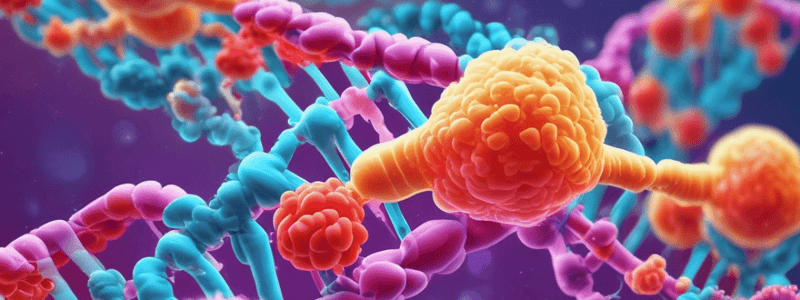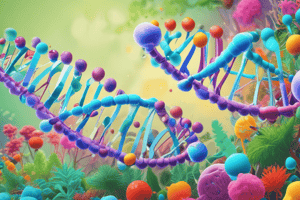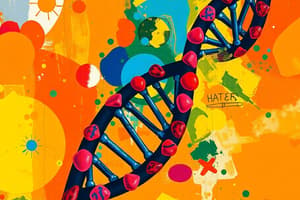Podcast
Questions and Answers
What is the primary function of chromatin?
What is the primary function of chromatin?
- Facilitating DNA replication
- Controlling gene expression
- Protecting DNA from damage (correct)
- Storing genetic information
What is the key structural unit within eukaryotic chromatin?
What is the key structural unit within eukaryotic chromatin?
- Nucleosome (correct)
- Nucleotide pair
- Chromosome
- Histone
Why is eukaryotic DNA organized into chromosomes?
Why is eukaryotic DNA organized into chromosomes?
- To increase nucleotide stability
- To enhance DNA replication
- To prevent chromosome breakage (correct)
- To promote histone synthesis
What is the significance of nucleosomes in chromatin structure?
What is the significance of nucleosomes in chromatin structure?
Which proteins are primarily involved in the formation of chromatin?
Which proteins are primarily involved in the formation of chromatin?
In eukaryotic cells, where is the genetic information stored?
In eukaryotic cells, where is the genetic information stored?
What did Watson and Crick suggest about the replication of the double helix?
What did Watson and Crick suggest about the replication of the double helix?
What is the complex combination made up of DNA and proteins in the nucleus called?
What is the complex combination made up of DNA and proteins in the nucleus called?
Why does the DNA need to be highly organized or condensed in a cell?
Why does the DNA need to be highly organized or condensed in a cell?
What is a thread-like coiled structure suspended in nucleoplasm known as?
What is a thread-like coiled structure suspended in nucleoplasm known as?
What is the primary function of histones in eukaryotic cells?
What is the primary function of histones in eukaryotic cells?
What is the significance of the centromere in eukaryotic chromosomes?
What is the significance of the centromere in eukaryotic chromosomes?
During which phase of the cell cycle does DNA replication occur?
During which phase of the cell cycle does DNA replication occur?
What is the primary function of the replication fork during DNA replication?
What is the primary function of the replication fork during DNA replication?
Which of the following statements about the cell cycle is correct?
Which of the following statements about the cell cycle is correct?
What is the primary function of telomeres in eukaryotic chromosomes?
What is the primary function of telomeres in eukaryotic chromosomes?
What is the significance of replication bubbles during DNA replication?
What is the significance of replication bubbles during DNA replication?
Which of the following statements about somatic cells is correct?
Which of the following statements about somatic cells is correct?
What is the primary function of the G2 checkpoint in the cell cycle?
What is the primary function of the G2 checkpoint in the cell cycle?
What is the primary function of the mitotic phase in the cell cycle?
What is the primary function of the mitotic phase in the cell cycle?
Flashcards are hidden until you start studying
Study Notes
Chromatin Structure
- Chromatin is composed of double-stranded DNA wrapped around an octamer of histone proteins.
- 160 bp of DNA wraps twice around a nucleosome core.
- 40 bp of linker DNA connects nucleosomes.
Histones
- Histones are the main structural proteins found in eukaryotic cells.
- They are low molecular weight, basic proteins with a high proportion of positively charged amino acids.
- Histones bind to DNA along most of its length, playing a crucial role in packing long DNA molecules.
Chromosomes
- Chromosomes are organized structures of DNA and protein found in the nucleus.
- They are composed of repeating 200 bp units called nucleosomes.
- Chromosomes are the carriers of genes or units of hereditary.
- They are condensed and visible during cell division.
Chromosome Structure
- Chromosomes have telomeres at the ends to protect them.
- They have a centromere that mediates migration during mitosis and meiosis.
- Humans have 23 pairs of chromosomes, consisting of 22 pairs of autosomes and 1 pair of sex chromosomes.
- Each gene is located at a specific gene locus on the chromosome.
DNA Replication
- DNA replication occurs in the nucleus during the S phase of the cell cycle.
- It is a semiconservative process that results in two new double-stranded molecules.
- Each original single strand is paired with one newly made single strand.
Replication Fork and Bubble
- A replication fork is a structure that forms within the nucleus during DNA replication.
- It is created by helicases, which break the hydrogen bonds holding the two DNA strands together.
- Replication bubbles allow DNA replication to speed up.
Cell Cycle
- The cell cycle consists of two major phases: interphase and the mitotic phase.
- During interphase, the cell grows and DNA is replicated.
- During the mitotic phase, the replicated DNA and cytoplasmic contents are separated and the cell divides.
Phases of Cell Cycle
- Interphase is divided into three stages: G1, S, and G2.
- G1 is the primary growth stage, lasting 11 hours.
- S is the genome replication stage, lasting 8 hours.
- G2 is the secondary growth stage, lasting 4 hours.
- M is the mitosis stage, lasting 1 hour.
- C is the cytokinesis stage.
Checkpoints
- G1 checkpoint is the main cell cycle checkpoint.
- If DNA is damaged, apoptosis will occur.
- Otherwise, the cell is committed to divide when growth signals are present and nutrients are available.
- G2 checkpoint is the mitosis checkpoint.
- Mitosis will occur if DNA has replicated properly.
Studying That Suits You
Use AI to generate personalized quizzes and flashcards to suit your learning preferences.




